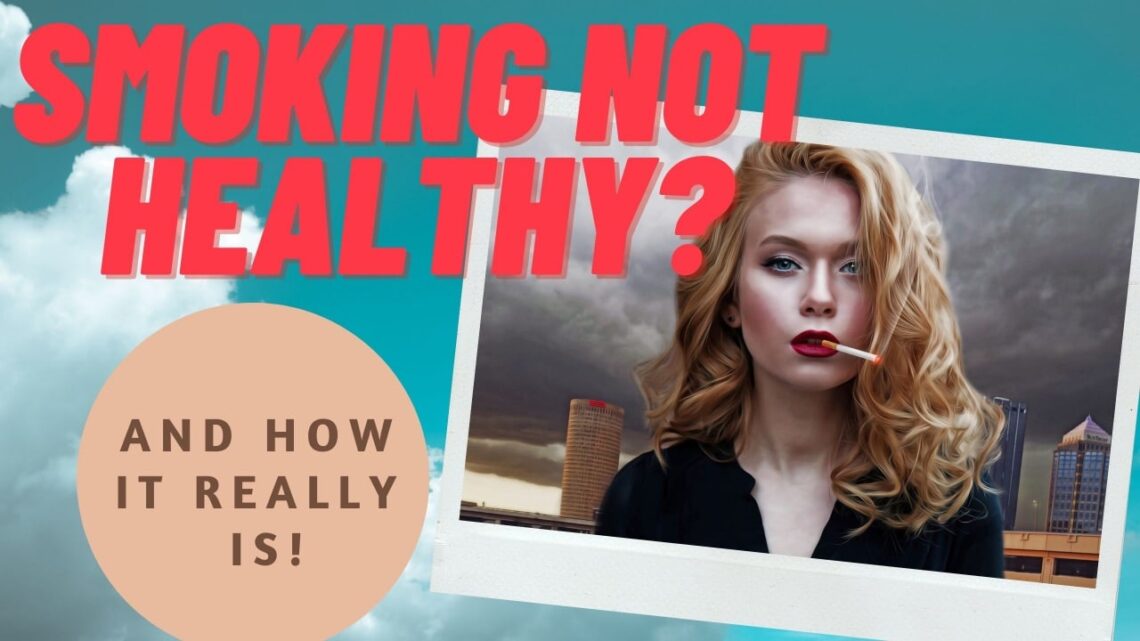
Smoking not good for health? Here is the clear answer!
Again and again people ask whether smoking is unhealthy. Even people with spiritual interests wonder this and would like a more detailed explanation. Here is the true background to smoking….
In the past, people were allowed to smoke everywhere. In every establishment you could find an ashtray on the table and it had not bothered anyone. Smoking was allowed in ice cream parlors, pubs, restaurants, even in airplanes and in every apartment. It was taken for granted and was also completely accepted.
Suddenly an anti-smoking campaign appeared, which started in the USA and spread globally. It incited the non-smokers against the smokers and smoking was increasingly banned indoors. Smokers accepted this desire and henceforth smoked outdoors.
But the anti-smoking campaign did not stop there. It wanted smokers to stop smoking in public as well, and the gap between them and non-smokers grew rapidly.
Then the worst photos of aggrieved smokers appeared and were even placed on every single cigarette pack – regardless of whether there was proof or not. Cigarette manufacturers were threatened with large fines and criminal charges if they failed to mention references to the enormous harm on their packs. There always had to be a photo and a warning to make people uncomfortable. Where did this sudden interest in discriminating against smokers and creating such a divide between non-smokers and smokers come from?
More anti-smoking Campaigns more Money
The countries of the world are taking advantage of this divide to raise prices more and more and to demand steadily more taxes. In production, a pack of cigarettes in Europe costs about 9 cents. The remaining amount is taxes. Tax money is important for the state so that they can build roads, institutional buildings, hospitals, schools, kindergartens, tanks and bomber planes and much more.
In German-speaking countries, a pack of cigarettes now costs between 5-7 euros. In comparison, take a look at Paraguay, for example. In this country, a pack of cigarettes costs between 30 and 50 cents. This enormous price difference shows how flexible taxes on a pack of cigarettes can be.
But when did this strange anti-smoking campaign start? Why has it now become important to so many countries around the world to look after the health of their citizens and make sure they don’t get sick from smoking? Is it really that important to the state?
The Nazis started it all
The anti-smoking campaign started with the Nazis in the 3rd Reich. After the war, however, it fell into oblivion and then arose once again in 1986, when a U.S. Secretary of Health and Human Services, acting on behalf of various pharmaceutical companies, suddenly warned of the severe health risks of smoking. More and more smoking bans were imposed in public buildings, not only in all indoor areas, but also in playgrounds, parks and restaurants. Some U.S. states even banned smoking in one’s own home or yard. Even today, in some U.S. states, to smoke you must move away from buildings and sit on a curb by the street while earning disapproving looks from passing pedestrians. If you work at Starbucks, for example, you’ll also be summarily terminated if you smoke near the store.
This anti-smoking campaign by the pharmaceutical and health ministers quickly spread to other countries, all the way over to Europe, and spread throughout the world. A real fanaticism emerged, a global smear campaign against smokers. This campaign spread even among spiritual people who like to think of themselves as tolerant, compassionate, and far from polarized thinking.
While many smokers accepted the wishes of non-smokers and withdrew, they could not always be persuaded to quit. A few years later, newspaper articles and television programs appeared indicating that dangerous additives had been found in cigarettes, such as arsenic, hydrogen cyanide, formaldehyde, and others. Apparently, many cigarette factories had now decided to add poisons to their cigarettes.
Why do cigarette companies offer products that are poisoned? After all, they make money from it!
Good question. Obviously, these companies and manufacturing plants are trying to maintain a good supply for smokers, but at the same time, they probably receive large sums of money for adding secret additives. So they are trying to maintain a balance between supply, legal requirements and recommendations of additives from the pharmaceutical industry.
Is smoking really unhealthy?
Smoking has never been unhealthy. Even today, many Indians smoke, although they are very close to nature and count many healers and medicine men among their tribes, which are by far more effective than the known conventional medicine. Their used and fermented tobacco plants have no additives. Also, the specious argument that passive smokers are even more at risk than active smokers has been refuted many times. On the basis of one of the most extensive long-term observations of the consequences of smoking, which began as early as 1959 on behalf of the American Cancer Society, started as early as 1972 and ended in California in 1998, the epidemiologists James Enstrom (University of California in Los Angeles) and Geoffrey Kabat (New York State University in Stony Brook) established that there was no increased health risk whatsoever from passive smoking. They stated, “Our results do not suggest a causal relationship between secondhand smoke and increased mortality.”
The Charité is Berlin’s most traditional hospital and, with more than 3,000 beds, one of the largest university hospitals in Europe. A surgical director cut open up to 60,000 lungs and could not find any smoker’s lung at all in smokers, which is so often postulated. So where did the rumors about smoker’s lungs come from? The first photos to prove smoker’s lung came not from a smoker who died of lung cancer, but from a miner at a coal-fired power plant. Thus, photos were used by the press that had no relation to smoking at all.
WHO again
Exciting also, who had supported behind the scenes very intensively the anti-smoking campaign: Again the WHO. Yes, exactly the WHO, which is also responsible for the media pandemic of the year 2020 to the present. The WHO states in Article 8(1) of the Framework Convention on Tobacco Control that “The Parties recognize that scientific research has clearly demonstrated that secondhand smoke causes death, disease and disability.”
To this end, for example, Professor Gerhard N. Schrauzer, President of the International Association of Bio-Inorganic Chemists, told the U.S. Congressional Committee in 1982, “No ingredient in cigarette smoke has ever been shown to cause lung cancer in humans. It has never been demonstrated in our laboratories that tobacco smoke has caused lung cancer.”
If the WHO is concerned about the health of smokers, but allows fluoride and drug residues to be poured into drinking water for this purpose, and even once publicly declared that radioactive pollution does not pose an environmental and health risk (see WHO statement), and also that pollution of the oceans or radioactive discharge into the oceans is not the pollution of the environment by particulate matter of importance, but smoking is, then one must be able to understand that there is something wrong.
Doesn’t that remind you of something?
Here are some excerpts from the Official Journal of the European Union of 30.11.2009 on the EU Council Recommendation on smoke-free environments:
Point 11: “Strategies to create smoke-free environments should include appropriate tools to enable a multi-sectoral approach in tackling smoking.”
Point 12: “Increased cooperation between Member States is needed to facilitate the exchange of information and best practices and to develop a standardized EU monitoring system.”
This should be enforced as follows:
Point 42: “Enforcement actions immediately after the legislation is enacted are particularly critical to its success and to the success of future monitoring and enforcement. In many countries, soft enforcement is recommended during the phase-in period, where individuals who violate the legislation are only warned, not punished. This approach should be pursued in conjunction with an active campaign to educate business owners about their responsibilities arising from the legislation, and businesses should demonstrate an understanding that the initial grace period or phase-in period will be followed by stricter enforcement.”
Point 43: “Once active enforcement begins, it is recommended in many countries that high-profile prosecutions be pursued to enhance the deterrent effect. When prominent individuals are found to have deliberately flouted the law and are known to society, authorities can demonstrate their resolve and the seriousness of the law by responding with rigorous and swift action, attracting maximum public attention. This will lead to increased voluntary compliance and reduce the resources needed for monitoring and enforcement.”
Item 45: “The effectiveness of a monitoring and enforcement program is enhanced by public involvement in the program. Gaining the support of the public and encouraging its members to monitor compliance and report violations greatly expands the reach of enforcement agencies and makes enforcement less burdensome. Indeed, in many countries, complaints from the public are the primary means of ensuring compliance. For this reason, smoke-free environment legislation should specify that individuals may file complaints and should authorize any person or nongovernmental organization to act to enforce compliance with environmental tobacco smoke exposure legislation. The enforcement program should provide for a toll-free complaint telephone hotline or similar system to encourage the public to report violations.”
And then, pursuant to Section 130(1) of the Penal Code, have that action fulfilled, because it states:
“Whoever, in a manner likely to disturb the public peace, 1. incites hatred, incites to violence or arbitrary action against a national, racial, religious group or a group determined by its ethnic origin, against parts of the population or against an individual because of his membership in a aforementioned group or part of the population… shall be punished by imprisonment from three months to five years.”
Also, arguments such as, “Passive smoking is child abuse! Beatings are now rightly considered child abuse. But while the bruises and redness left by a slap or spanking generally soon disappear, the many irritants and carcinogens in tobacco smoke often cause acute and even permanent damage to the health of children who smoke passively” have been used to declare war on smokers.
Unfortunately, this has not fully worked so far, but it will certainly work better with vaccinations. Apparently, it is not about the health of fellow citizens, but rather about the creeping enforcement and preparation for a health dictatorship.
Contradictions to Smoking
Greece and Japan, countries where you can smoke anywhere you want. Especially in Greece and surrounding islands, you can still find ashtrays on the table in every pub and restaurant. Greece has never been greatly influenced by the anti-smoking campaign. This, of course, led to the fact that Greece and Japan, in particular, have the most cigarette smokers. The anti-smoking campaign had the greatest impact in the USA, Australia and Russia. Now, one may guess in which countries the lowest lung cancer rate exists? Correct, Greece and Japan.
It’s Sunday afternoon. The barbecue is starting today. Every self-respecting man is allowed to take a turn at the barbecue and get his hands on the coveted steaks. Smoking is not allowed in the garden, because it is harmful. But those in the know are informed that a man who stands in front of a grill for an hour, searing meat and inhaling the smoke, has comparatively smoked over 50 cigarettes during that period.
From this you can see how skewed views on smoking are.
How can it be that a U.S. state has the power to expand its anti-smoking campaign worldwide?
Apparently with the help of the pharmaceutical industry, which can be found all over the world. It acts like the Deep State, which, like a shadow government, exerts its global influence behind the many different governments. This is all very reminiscent of the vaccination lobby that has been set in motion since 2020. Many critics of the Deep State (NWO) are convinced that the pharmaceutical industry and the WHO are its main players.
Why the anti-smoking campaign, when the state earns so much in taxes from the high cost of cigarettes and the pharmaceutical industry gets more and more patients from “harmful” smoking?
Right, that would be a big contradiction. Actually, the pharmaceutical industry should be pleased to receive many smokers as patients, because they do not like to give up cigarettes. This contradiction is only resolved if smoking has no negative effects on the human body at all. The only solution would be to add secret additives to cigarettes so that smoking would eventually cause health problems after all, thus proving the pharma right.
What do Chemtrails have to do with Smoking?
The crazy and hardly credible conspiracy theory about chemtrails has gained more and more popularity over the years and what sounded abstruse in the beginning has now been confirmed more and more. Chemtrail pilots declared that they actually dropped agents with their airplanes over the countries, photos of tanks in airplanes were presented and scientific reports were published that clearly proved that chemtrails were already used for weather manipulation in the Vietnam War and are still applied elsewhere today. But not only weather manipulation, but based on many assumptions, also heavy metals, viruses and other pathogens. But where is the connection to smoking here?
One examined human lungs, which were exposed for a longer time to a high Chemtrail load and determined something completely crazy: The Chemtrail fibers reacted to no medicines or treatments, but with cigarette smoke they reacted, came into movement and loosened, so that they could be coughed out, or could not at all foot.
A woman who conducted experiments to release chemtrail fibers from the lungs, or get them moving, discovered amazing things when she did experiments with cigarette smoke and nicotine:
“After 40 years of heavy smoking, my husband and I had healthy lungs, according to X-rays. By means of acupuncture, for 100 euros per person, we managed to stop smoking. After eight months, without smoking, on the new X-rays they found negative changes in the lungs of both of us…”
This vehement contradiction prompted her to do her own research, because she wanted to know what it was really like. So she began using a wide variety of scents and incenses to get the chemtrail fibers out of her lungs so she could recover – but to no avail! But then came the breakthrough!
“I blew on the (chemtrail) fibers in between, you can see if they’re wafting or moving on their own from the tobacco smoke, by the way they didn’t respond to needle, sage or mint smoke.”
She noted that smoking and nicotine also put a protective layer over the lungs, making it harder for chemtrail fibers to hook on and then be expelled again when coughed on.
Now, whoever commissioned the chemtrails, could he possibly be the same person who started the anti-smoking campaign?
Is Smoking really unhealthy? Here is the clear answer!
It is not smoking or tobacco that is unhealthy, but only the secret additives that do not have to be declared on the manufacturer’s cigarette packages. This leads to the logical conclusion that the only thing that matters when smoking is the brand of cigarette.
The most well-known and popular cigarette brands, i.e. those that are most frequently purchased, have these unhealthy additives. However, there are some cigarette brands that do not have additives and whose enjoyment, in my opinion, is still completely harmless so far. Among them are the brands “Manitou“, “American Spirit“, “Kentucky” and “Pueblo“. So if you absolutely want to continue smoking, you should limit yourself to these brands in any case.
The most suitable brand is probably “Manitou“. Strange that this one has an Indian name, isn’t it?
Certainly, there may be one or two other cigarette brands that could also be classified as harmless, but these are not known to me.
Is Vaping better than smoking Cigarettes?
Again, the same formula applies. Many applicable liquids for vapes possess equally secret additives and unknown chemistry. Some do not possess these. You can apply this “formula” to anything that has to do with smoking. Likewise, this “formula” can also be applied to food of all kinds and is responsible for the so-called food intolerances and pseudoallergies. But this is another topic.
I would like to emphasize here that the information given here is my personal view and I refer to external sources and some self-experiments. I do not advise smoking, nor do I advise quitting. This is a decision that everyone must make for themselves, as each person should decide on their own responsibility.
See also:
The Books of the Matrixblogger in English
Visit the “Matrixblogger” on Youtube!
Sources:
Sackstark Blog
Die Welt
Sybille Schrei Blog
Bürgerinitiative “Sauberer Himmel
Rauchen schadet Chemtrail-Fasern
Rauchen schützt vor Lungenkrebs
Kräutermume Blog
Umfassende Stellungnahme zu gesundheitlichen Auswirkungen des Rauchens
Tabakdokumente – eidesstattliche Versicherung
Tabakdokumente bzgl. Passivrauchen






